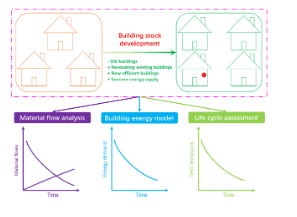A bottom-up dynamic building stock model for residential energy transition: A case study for the Netherlands

Nearly 80% of electricity could be met if photovoltaic systems are installed on half of roofs.” This reminds me of a similar conclusion made in Withouthotair.
The building sector plays a key role in energy transition and carbon reduction while capturing the dynamic characteristics (e.g. materials, energy performance, and environmental impact) of building stock is a great challenge during the gradual process. This study presents a bottom-up dynamic building stock model that links dynamic material flow analysis with building energy modeling. The environmental impact of material and energy requirements is assessed by considering future electricity mix. The model is applied to evaluate the pathways to the climate-neutral energy supply of residential building stock in the Netherlands by 2050. Results show that space heating demand decreases by about 2/3 by 2050, while the energy for hot water increases to 92% of space heating demand. 80% of public grid electricity for appliances and lighting can be potentially substituted if rooftop photovoltaic (PV) systems are installed on 50% of renovated buildings and all the new buildings. Greenhouse gas (GHG) emissions of operational energy are reduced by approximately 60–90%, depending on the electricity mix. Annual GHG emissions from material production are not as important as those related to operational energy. Insulation materials account for a large proportion of the carbon footprint of material production. The model has a high spatial and temporal resolution and can be linked with local energy source availability (e.g. buildings or neighborhoods) to provide more accurate support for policymaking.
